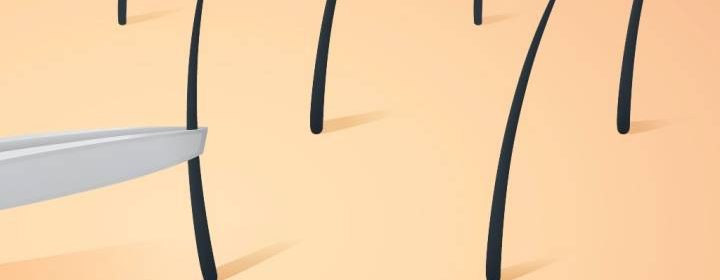Here’s why you keep finding long, dark single hairs on your body

Have you ever looked in the mirror and, to your surprise, found a hair on your chin that wasn’t there before?
It’s not an uncommon experience — especially for women, according to dermatologist Dr. Julia Carroll of Compass Dermatology in Toronto.
Why these hairs — which are often longer and darker than your other hair — grow is “a bit of a mystery,” Carroll told Global News.
She speculates that hormones are often at play, “but it can also happen randomly,” Carroll said.
“They do tend to show up in areas that are hormonally influenced.”
This can include the skin around your chin, jawline and your areolas (the tissue surrounding your nipples).
Chronic illnesses like polycystic ovarian syndrome (PCOS) and certain medications can also contribute to the growth of these hairs.
How to get rid of them
If you’re looking for a quick fix, Carroll recommends plucking.
“It’s a good option… but it’s not the best option,” she said. “For anyone who wants a more permanent solution, laser hair removal is better.”
The treatment uses light to target hair underneath the skin and kills it at the root.
Unfortunately, this treatment only works if your hair is dark. “The laser doesn’t see light colours, like blond, light brown or red hair,” said Carroll. “It has to be black or dark brown”
If you want to undergo laser hair removal, you need to resist the urge to pluck hair at all costs.
“Once the hair is out, you have to wait for that hair to grow back,” Carroll said.
“Instead, you should just trim it at the skin’s surface… otherwise, the laser won’t be able to target that hair follicle.”
Dr. Lisa Kellett of DLK on Avenue, also a board-certified dermatologist, recommended laser hair removal and another treatment known as electrolysis.
“It’s using electricity to basically treat the hair,” Kellett said. “It’s multiple treatments over time, and what it does is it treats the hair follicle by heating it up.”
If neither of these options is right for you, Carroll recommends consistent exfoliation in the areas where you most commonly find these random hairs.
“You can’t prevent their growth, but if you exfoliate, you can prevent them from becoming ingrown,” Carroll said.
Ingrown hairs
Ingrown hairs aren’t pretty, and they’re often uncomfortable, too.
These “random” hairs are more prone to becoming ingrown because they are so thick and coarse, said Carroll.
“Usually the hair is protected by the follicle [and] the rest of your body doesn’t see it… then it comes out of the skin, and it’s not in your body technically anymore,” she said.
“When you get an ingrown hair, that hair follicle and the proteins associated with it are then exposed to the immune system, which sees it as foreign.”
This can lead to redness, inflammation and itchiness.
Given the discomfort these hairs can cause, a lot of people will try to get rid of them. However, using at-home techniques can leave you vulnerable to infection.
“When [people] start to manipulate or pick… maybe they’re using dirty hands or a dirty pair of tweezers or some other instrument, and they can introduce bacteria into an already inflamed situation,” Carroll said.
The safest way to remove an ingrown hair is by gently exfoliating the area until the hair comes out naturally.
If you’re prone to ingrown hairs, Carroll says there are more permanent options for you.
“I might put them on a medicated lotion — maybe one that has glycolic acid in it — so that it’s slowly taking layers off the skin, and that’s also preventative along the way,” she said.
You could also use a physical exfoliator with “grains” or “beads” in it that would help guide the hair out.
“You want to do that gently,” Carroll said.
Whatever you do, don’t try to pluck an ingrown hair.
“I see a lot of [patients] who come in with ingrown hairs, but the ingrown hairs are not the problem,” said Carroll. “It’s what they’ve done to their skin to get at the ingrown hair.”
Often, the damage can present similarly to acne scars — but it’s completely preventable.
Carroll recommends always consulting a board-certified dermatologist before attempting anything by yourself at home.
Does your hair grow back thicker after you pluck it?
This is an old wives’ tale that “doesn’t make any sense,” said Kellett.
“That’s the same thing as people saying if you cut your hair, it will grow faster,” she said. “Cutting your hair has absolutely nothing to do with the growth at the dermal pillow, which is at the base of the hair follicle.”
Sign up for our Health IQ newsletter
© 2019 Global News, a division of Corus Entertainment Inc.
Source: Read Full Article



